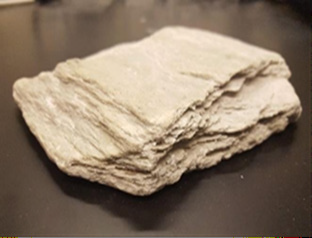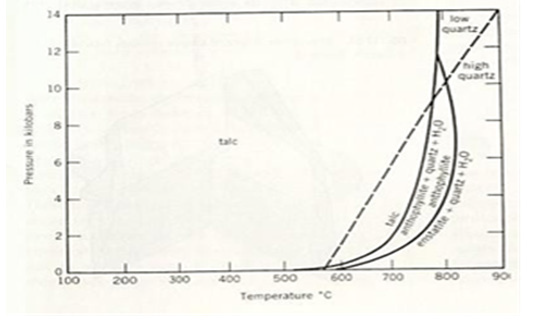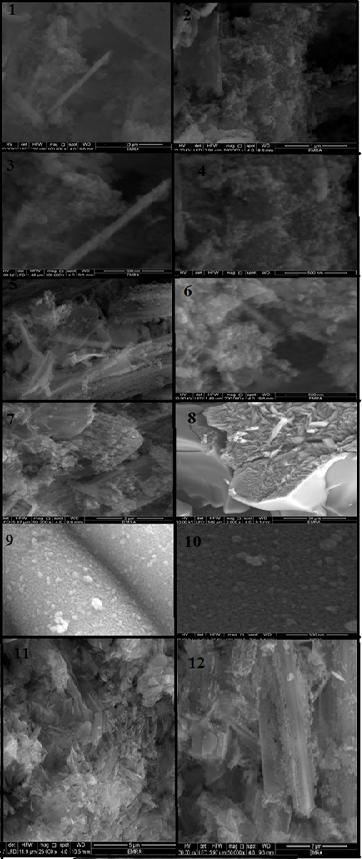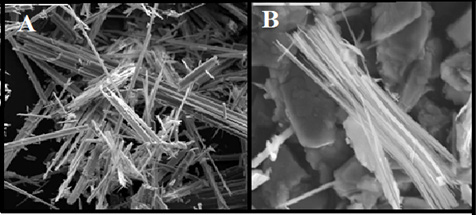Research Article 
 Creative Commons, CC-BY
Creative Commons, CC-BY
Discovering of Asbestos Fibers and Corn Starch in Talc Material for Baby Powder Samples from Different Markets in Benghazi City
*Corresponding author: Mariam Farag Ambarak, Benghazi University, Benghazi, Libya.
Received: June 12, 2023; Published: June 21, 2023
DOI: 10.34297/AJBSR.2023.19.002566
Abstract
This work gives mastery over the asbestos fibers that found their way to talc material in baby powder. There are two kinds of baby powder made up of
1. Baby powder is based on talc material with components.
2. Baby powder is based on corn starch with talcum.
New research pointing to the connection of asbestos molecules and several types of cancers. Asbestos is naturally appearance, and it was used as thermal insulating material in factories and has been illicited for its risks on the workingman. The most widely used method to detect asbestos fibers is microscopes and the SEM it was used in this study to detect asbestos fibers in different products from local markets further more iodine test to discover if the product have a starch. In this work sex of twelve samples of baby powder may contain asbestos fibers, and two contain starch.
Keywords: Asbestos, Baby powder, Talcum, Corn starch
Graphical Abstract
(Figure)
Introduction
Talc Material
Talc, a hydrated magnesium silicate, with a chemical structure of Mg3Si4O10(OH)2 [1] structure in talc is made up of SiO4 tetrahedral layers. Form six member rings, and sandwich an octahedral layer made of magnesium ions and hydroxide groups this unique structure allowing them to break off easily. Their structures, as well as its fine texture, give it the ability to yield on many forms. The flexibility of this rock kind makes it a popular component in cosmetics, paint, rubber, ceramics, and paper. Given its content in many common products, it is essential that talc is refined correctly in order to prevent long-term destruction to the general community. People commonly used powders to protect, dry and perfume their skin, and the talc material is the most used for its softness and ability to absorb moisture and provide lubrication at the same time. This material is naturally occurrence and safely used for hundreds of years Figure 1 shows the providential natural structure of talc material [2].
Asbestos
Asbestos is a group of naturally occurring circuitous minerals. Before being registered as a carcinogenic, asbestos was used for a range of applications including roofing, insulation, flooring, brake packs, and millboard. Its thermal and flexible structure properties made asbestos a widespread choice for these purposes [3]. Asbestos contains many kinds of minerals chrysotile, anthophyllite, and tremolite are the three most commonly found minerals that contaminate talcum powder. These minerals have a chemical structure of Mg3Si2O5 (OH)4 [4].
Talc Polluted with Asbestos Fiber
Pollution of talc with asbestos begins in the taking out of the mineral process. If the talc is not extracted carefully enough, it is possible that asbestos minerals can be pulled out as well. Since talc, as well as the many rocks that contain the minerals found in asbestos, are metamorphic, they will both be found within mistake lines where the pressure and temperature is in elevation. In the presence of carbon dioxide, circuitous transforms into talc and magnesite (Equation 1) [5].
2Mg3Si2O5 (OH) 4 + 3CO2 → Mg3Si4O10 (OH)2 + 3MgCO3 + 3H2O (Equation1)
Furthermore, at high temperature and pressure, talc becomes unstable and breaks down into several products. Figure 2 shows that when talc reaches a temperature of approximately 700°C and a pressure of 2 Kilo bars, it begins to break [6]. There are several ways in which asbestos minerals can pollute talc; therefore, it is important that talcum powder as well as talc-containing products are tested for potential asbestos pollution before going to the marketing process.
Toxicity of Asbestos
There are various diseases directly connected to continuing exposure or breathing of asbestos. No amount of exposure to asbestos is healthy; however, contact with airborne asbestos fibers can lead to diseases that include asbestosis, lung cancer, and mesothelioma [7]. Asbestosis, caused by the breathing of asbestos, leads to difficult breathing that worsens over time due to a decrease in diffusing ability in the lungs. This disease commonly affects the lower region of the lungs and can only be diagnosed by evaluating the lung tissue using critical light microscopy [8]. Pleural plaques are often found in patients with asbestosis and are white or yellow smooth surfaced lesions on parietal, visceral, and diaphragmatic pleura. These scratches are often used as evidence that someone has been exposed to asbestos. Lung cancer is accountable for the largest number of deaths involved in patients who are exposed to asbestos [9]. Individuals who are exposed to asbestos, but also subject their bodies to other types of carcinogens such as cigarette smoke, are more likely to contract lung cancer. Mesothelioma is a type of cancer related to asbestos exposure, but not associated with smoking cigarettes [10]. It is often found in those people who were exposed to large amounts of asbestos in their lives. If the mesothelioma is malignant, it will often spread to the surfaces of the lung, thoracic, and abdominal cavities [11]. If an individual is exposed to any amount of asbestos, especially in the long-term, it could lead to adverse health effects that are permanent.
In 2009, results from a investigation study found an increased rate of another kind of cancer that may causing because of asbestos exposure. This kind is bile duct cancer was spread between patients who had continuous attached job-related exposure to asbestos. Bile ducts link the gallbladder gland to the liver and duodenum. That provides enzymes for digestion. Asbestos fibers can become locked in these small tubules [12].
Ovarian Cancer is another kind of cancer that asbestos fiber may cause and happened in 2009 the Scientists established the relation between asbestos fiber contact and ovarian cancer. Asbestos fibers may travel in the blood circulation, lymph system or reproductive system. Clinical Research Study recorded in in 2021 that a lot of persons with job-related to mineral of asbestos fiber exposure ensure have a tow-quarter double raising possibility too dangerous of death with ovarian cancer on usual. The scientists encouraged that job-related ovarian cancer should be assigned the same recognition necessities as in occupational lung and laryngeal cancer. Other cancers may be supplementary with asbestos fiber contact take in kidney cancer, throat cancer, gallbladder cancer, and esophageal cancer. Studies on the connection between asbestos and these malicious growths are unpredictable. There are suspicions link the asbestos to these dangerous deadly diseases, but the true connection has not detected yet [13].
Instruments Used for Recognized Asbestos Fiber in Talc Powder
Various instrumental methods have been used in testing talc-containing products for asbestos and other potential contaminants. Usually, these methods include both microscopic technique and spectroscopic techniques. The FDA proposal for talc regulation in 1973 used Polarized Light Microscopy (PLM), which required mixing a sample of talc with 1.574 and 1.590 refractive index liquids, observing the samples using PLM, and counting the number of fibers that fit certain criteria. 23 It is estimated that approximately 20,000 particles would have to be examined for each talc-containing product, a time-consuming process. A.M. Blount suggested a technique using a micro centrifuge to separate the amphibole minerals and talc by density and then viewing the amphibole fibers using PLM to get a more accurate count in a shorter period of time [14]. There is another kind of microscopy, electron microscopy, that can be used for this type of analysis procedure. Electron microscopy is separated into two major types of familiar microscopy, Scanning Electron Microscopy (SEM) and Transmission Electron Microscopy (TEM). The difference between these techniques is the type of image that they produce. According to Skoog, et al., the SEM images the external morphology of the specimen whereas the TEM images the internal structure [15].
Starch in Baby Powder
Talc. powder has been established to be a harmful character in resent time, with various research appealing that talc can cause different kinds of cancers for internal body organs when used for a long sequence time. At present, there are some panels of judges who have been definite there was enough marks to advise that the talcum was main reason in evolving cancer in three women [16]. So that the community has been finding other material substituted to talc and consider safe to use. individuals Even though similar look like to the form of talc, corn starch is synthetic of bigger constituent part and made from corn. It’s a widespread component for various kinds of foods and has been founded in sweetmeats, soups and sauces [17].
What is the Difference between Talcum Powder and Cornstarch? : The comparing between the talcum powder and starch may take from deferent faces . in the beginning, talcum powder is formed from rock kind of several mineral whereas corn starch is prepared from a diet ingredient. Corn starch has a bigger constituent part, so it has been considered to be a safer form of baby powder compared to talc [18]. However, cornstarch could still cause respiratory problems if inhaled in large quantities. Studies suggest that when talcum powder is used on the perinatal area, it’s possible for the talc particles to travel through the womb, up the fallopian tubes and into the ovaries. Because of the inorganic nature of talcum particles so that the cells of human body cannot be Due to the fact that the body cannot cracking up talc particles, they can cause oncogenic cells to grow. Corn starch is observed by researchers as a nontoxic and talcum powder should be escaped [19] in this work twenty baby powder samples from deferent locations were used to discover asbestos fibres and corn starch ingredient in the talc material for twelve of baby powder samples from Benghazi markets and pharmacies.
Experimental Part
Characterization of Asbestos Fibres
Scanning Electron Microscopy (SEM, Tescan VEGA2 SB) has been used to identify the morphological features of asbestos fibres. The SEM images can determine the most important two things: the shape and the size of the particles.
Characterization of Corn Starch Ingredient
The starch can be detected by standard method called “iodine test” where the starch reacted with iodine to form a complex with obvious blacked blue colour due to the founding of a charge-transfer complex. If the solution doesn’t contain starch the colour of solution remains yellowed brown. 1g of baby powder sample was suspended in 50ml of 25% Ethanol and drops of 0.5M of iodine solution have been added and the changing in the colour was recorded.
Result and Discussion
For this research twelve samples of baby powder have been used, most of them have high end brand names. May la Bebek pudrasi( turkey), Surprise (turkey), Johnson’s baby powder blossoms (indonesia), Nunu paby powder (K.S.A), Enchanteur(malaysia), Pond’s (india), Cussons baby(england), Beautiful perfumed talc (libya), dolin baby powder(turkey), Johnson’s blossoms (malaysia), Chicco talcum powder (italy).
Scanning Electron Microscope (SEM)
The images show that some of the samples contain fibres seem like asbestos material and that fibres similar to SEM standard image of asbestos. the images taken with the SEM were compared to images of standards from the United States Geological Survey to determine the types of asbestos present in the control. Figure 4, appears to show SEM image of a chrysotile asbestos standard). at least two types of asbestos. The fibers appear to be chrysotile (A) while the rod-shaped objects could be anthophyllite (B). After reviewing the images taken with the SEM, possible asbestiform minerals have been found in six of the twelve baby powder samples: May la Bebek pudrasi(turkey), Surprise (turkey), Johnson’s baby powder blossoms (indonesia), Pond’s (india), Cussons baby(england), Beautiful perfumed talc (libya). The images obtained from the baby powder samples shown in Figure 3 (Figures 3,4).
Corn Starch Test
This test was performed to evidence of starch appearance in baby powder samples. This test result three of twelve samples contain starch by converting the colour of the solution to dark blue when the iodine solution was added. The appearance of the starch may improve the quality of the baby powder and we recommend using these products. The samples that contain starch are Chicco Talcum powder (Italy), Nunu baby powder (K.S.A), Enchanteur (Malaysia). Figure 5 shows starch test on baby powder samples.
Conclusion
Despite the common misconception that powders are only for baby and infant, they have been used for centuries by men, women, and children alike. This is why it is important to have enforced regulations in place to keep the general public safe. The use of contaminated talc products over a long period of time could be detrimental to many lives, as seen through the numerous talcum powder lawsuits that have been filed. Even though talc is easily contaminated by asbestos in the mining process, a more refined purification process could prevent the use of asbestos contaminated talc in powder products. To determine the identity of the suspected asbestos contaminants, further testing of these samples using X-ray diffraction is required.
Acknowledgment
None.
Conflicts of Interest
None.
References
- Lopez Galindo A, Viseras C, Cerezo P (2007) Compositional, technical and safety specifications of clays to be used as pharmaceutical and cosmetic products. Appl Clay Sci 36(1-3): 51-63.
- Paye, M (2005) Handbook of Cosmetic Science and Technology. Hoboken: Taylor and Francis Group.
- Parry C Eaton J (1991) Kohl: A Lead-Hazardous Eye Makeup from the Third World to the First World. Environmental Health Perspectives 94: 121-123.
- Talc (2016) http://www.fda.gov/Cosmetics/ProductsIngredients/Ingredients/ucm293184.htm.
- Blount A (1991) Amphibole Content of Cosmetic and Pharmaceutical Talcs. Environ Health Perspect 94: 225-230.
- Cosmetics (2018) https://ec.europa.eu/growth/sectors/cosmetics_en.
- (2018) Regulation (EC) No. 1223/2009 of the European Parliament and of the Council of 30 November 200 on Cosmetic Products.
- Hurlbut CS, Klein C, Dana JD (1997) Manual of Mineralogy, 19th John Wiley and Sons: New York.
- Mainprice D, Le Page Y, Rodgers J, Jouanna P (2008) Earth Planet. Sci Lett 274: 327-338.
- Klein C, Philpotts A (2017) Earth Materials. Cambridge University Press: Cambridge.
- IARC (2018) Asbestos (Chrysotile, Amosite, Crocidolite, Tremolite, Actinolite, and Anthophyllite).
- Paoletti L, Caiazza S, Donelli G, Pocchiari F (1984) Evaluation by Electron Microscopy Technique of Asbestos Contamination in Industrial, Cosmetic and Pharmaceutical Talcs. Regul Toxicol Pharmacol 4(3): 222-235.
- Klein C (2002) Manual of Mineral Science. 22nd Wiley: New York.
- Deer W, Howie R, Zussman J (1992) An Introduction to the Rock-Forming Minerals. 2nd Longman: Harlow.
- (2018) When is Asbestos Dangerous?.
- Manning C, Vallyathan V, Mossman B (2002) Int Immunopharmacol 2: 191-200.
- (2018) Talcum Powder Settlement - Ovarian Cancer Verdicts & Payouts.
- Weyant C (2018) Talcum Powder Lawsuits.
- Lovell T (2018) FDA investigating reports of tremolite asbestos in makeup.









 We use cookies to ensure you get the best experience on our website.
We use cookies to ensure you get the best experience on our website.